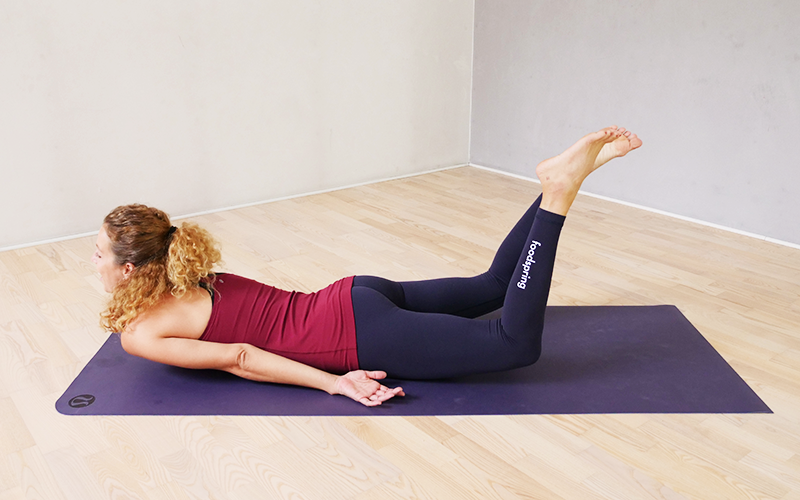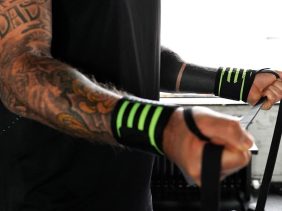Locust Pose – What it is and how to do it
 ©foodspring - So geht's
©foodspring - So geht's
Locust pose (salabhasana) is one of the best exercises for your back, whether you’re a yoga fan or not. If you’re concerned that the amount of time you spend at a desk may be impacting your back, this pose will help you feel your best no matter what. Find out how to do it below!
What is locust pose?
Locust pose, or salabhasana in Sanskrit, is a powerful yoga pose. It strengthens your back, improves posture, and prepares your body for doing backbend exercises, whether that’s in upward facing dog or wheel pose. In this exercise, you lay on your stomach while simultaneously lifting both your legs and upper body.
Benefits of locust pose (salabhasana)
Salabhasana can have many positive effects on the body and mind. These are the ones you’re most likely to experience:
- Strengthens the back muscles, especially the flexor muscles and erector muscles of the spine
- Strengthens the glutes and hamstrings
- Activates your quads
- Activates muscles in your arms
- Increases hip flexibility
- Improves posture
- Opens your chest
- Stimulates your abdominal organs
- Revitalizes your whole body
Yoga can soothe the body and mind. But before you can soothe your mind, the rest of you has to be healthy. A well-balanced diet is key to ensuring you feel your best both physically and mentally. The better you eat, the better you’ll perform.
How to do it correctly
When performed correctly, locust pose can be an incredible exercise for the entire back. In the photo below, yoga teacher Jenny demonstrates an ideal execution.
How to get started
You’ll begin this pose lying flat on your belly, legs straight, with your forehead on the ground, hands near your hips, and palms pointing upwards. Then, anchor your hips to the ground and pull your shoulder blades backwards until your shoulders begin to lift off the ground. As you breathe in, lift both your arms and legs. Keep your legs straight and extend your arms actively. Continue to breathe deeply and evenly, trying to move your chest up a little bit higher with each inhalation. Be sure to keep your arms straight and toes pointed and don’t lift your head.
Locust pose checklist
- Neck is in line with spine and gaze is on the ground in front of you.
- Palms are facing the sky.
- Shoulders are pulled back.
- Abs are contracted.
- Hips are anchored to the ground.
- Legs are extended backwards.
- Arms and legs are lifted at the same time.
- Keep your neck long.
Warm-up exercise
Locust pose can be especially difficult for beginners because it’s not easy to see yourself when you’re lying on the ground. If you’re not sure if you’re doing everything right, this warm up will give you an idea of what to be on the lookout for:
Lie on your stomach and place your forehead on the floor. As you would in a locust pose, place your hands on the floor with palms facing the sky. Now, concentrate on your legs. Anchor your toes firmly to the floor. Lift alternating legs a few centimeters from the floor, while tilting your pelvis towards the floor. Feel which muscles are being used. Then lift both legs and anchor your pelvis to the floor to transition into a full locust pose.
If you struggle to lift both legs at the same time, try practicing a variation of this pose with just one leg. Lift each leg 8 times, then extend your arms 8 times. If you do this once every day, you’ll be able to lift both legs at once in no time.
The Secret to Success: Tighten and Loosen
Locust pose stretches your back muscles. It can be seriously physically demanding and definitely requires a certain amount of discipline. In spite of this, it’s important to try to stay as relaxed as possible in order to reap the many benefits of this pose.
After holding Salabhasana for several breaths, slowly relax out of the pose as you exhale. Place one cheek on the ground and let your heels fall to the side so that the big toes touch. Taking this moment of rest greatly relaxes your lower back. If necessary, tilt your pelvis from left to right to further relax your hips and back.
It’s always a good idea to do this pose twice. After the second round, rest your other cheek on the ground and relax your back again.
Common Mistakes
It’s easier than it seems to make mistakes in this pose. Keep your focus on executing the movements properly rather than pushing it to the limit.

| Mistake: | Your neck is too tight. | |
| How to avoid it: | Turn your gaze towards the ground in front of you. Lift your chin a few centimeters while keeping your neck long. | |
| Tip: | Imagine you’re looking down at yourself, or use your phone to record yourself doing the pose. Your head and neck should form a natural line with your spine and shouldn’t be twisted. |
| Mistake: | Your palms are resting on the floor. |
| How to avoid it: | Before starting locust pose, flip your hands so that the back of each hand is resting on the floor. |
| Tip: | This rotation of your arms is essential to open your shoulders properly. |
| Mistake: | Your legs are bent. |
| How to avoid it: | Contract your thighs when you extend your legs. |
| Tip: | Focus on length rather than height. Try to stretch your legs as much as possible. Maintain this position and, with each breath, try to raise your thighs a couple more millimeters. Whenever you reach your own highest point, hold the position. |
| Mistake: | Giving up too quickly. |
| How to avoid it: | Choose a variation that isn’t too much for you. You should be able to hold for at least five breaths without struggling. |
| Tip: | Listen to your body and choose what works for you. Practice makes perfect. |
Do you feel like you aren’t flexible enough to do yoga or to do locust pose? You can easily improve your range of motion with our 10 simple flexibility exercises. Incorporate them into your daily routine whenever or wherever you are and you’ll be ready for yoga before you know it. Or try one of our very own workouts!
Variations of locust pose
Most yoga classes incorporate the most classic version of locust pose that we’ve described above. However, there are plenty of variations that you might come across.
The half locust
This variation is similar to the warmup we described above and is ideal for beginners. Lift only one leg at a time while keeping your chest flat on the ground, or alternate: first lift both legs, then put them down and lift your head and chest off the floor.
Hands behind your back
This variation is only slightly different from the original. Cross your hands behind your lower back and keep your elbows slightly bent. Pull your shoulder blades back so that your chest fully opens up.
Conclusion
- Locust pose salabhasana strengthens the back muscles.
- It’s an ideal warm up for bridge or upward facing dog pose.
- Locust pose strengthens the butt and activates the arm muscles.
- Different warm ups can help prepare you for this pose.
Sources for this article
We at foodspring use only high-quality sources, including peer-reviewed studies, to support the facts within our articles. Read our editorial policy to learn more about how we fact-check and keep our content accurate, reliable, and trustworthy.





























